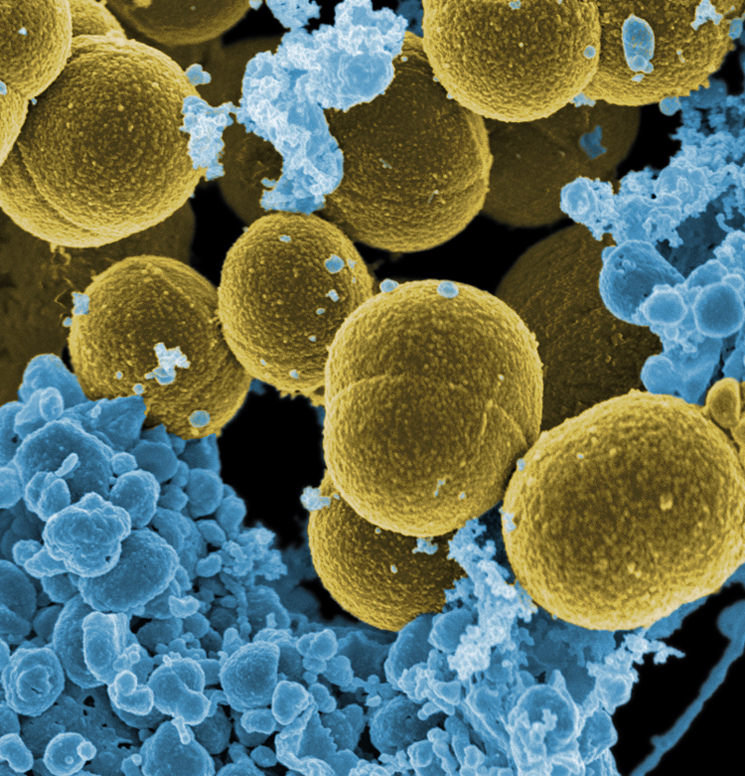Staphylococcus aureus Vaccine Design Service
Creative Biolabs is a company specializing in vaccine development. During the company's more than ten years of development, it has gradually established a comprehensive and systematic research and development strategy. We have in-depth and extensive research on bacteria, viruses, and tumor vaccines. Our team of scientists has developed a wide range of vaccine products and services to meet your specific needs in vaccine design and optimization, preclinical evaluation, and GMP production.
Staphylococcus aureus
Staphylococcus aureus can infect people of all ages, including children, the elderly, and immunosuppressed individuals, usually develop into a serious condition after infection with the bacteria. S. aureus can be colonized in the human body without any symptoms, but also can cause clinical symptoms of different severity. The bacterium is a major pathogen of skin and soft tissue infections as well as pneumonia, osteomyelitis, sepsis, and arthritis. Newborns and children under 1 year of age in low-income countries are at high risk of S. aureus infection and mortality rates are as high as 50%. A typical Staphylococcus aureus is a spherical type having a diameter of about 0.8 μm and arranged in a cluster of grapes under a microscope. Staphylococcus aureus has no spores, flagella, most of which are non-capsulated, and Gram-positive. The newly emerging methicillin-resistant Staphylococcus aureus (MRSA), known as super bacteria, is almost resistant to all human drugs, and only vancomycin can resist it. Hospital-associated MRSA (HA-MRSA) is the leading cause of nosocomial infections. Although vancomycin is still the first choice for the treatment of HA-MRSA infection, more and more reports indicate that the bacteria's sensitivity to the antibiotic is declining.
 Distributed under CC BY 2.0, from Wikimedia, without modification.
Distributed under CC BY 2.0, from Wikimedia, without modification.
Pathogenicity of Staphylococcus aureus
Staphylococcus aureus is ubiquitous in nature, and the US Centers for Disease Control states that infections caused by Staphylococcus aureus are second only to E. coli. Food poisoning caused by the bacteria is a worldwide problem. The bacterium is also the most common pathogen in human purulent infections, and its pathogenicity depends on the toxins and invasive enzymes. The toxins and invasive enzymes of Staphylococcus aureus are mainly the following. Coagulase can cause plasma agglomeration and coating on the surface of bacterial cells to prevent bacteria from being phagocytized; hyaluronidase can destroy hyaluronic acid and help bacteria to spread; deoxyribonuclease can degrade host DNA, staphylokinase dissolves fibrin, which can promote the spread of pathogens and β-lactamase helps bacterium resist drugs. S. aureus is capable of producing a variety of exotoxins. Among them, superantigen can cause toxic shock syndrome; and staphylococcal scalded skin syndrome caused by exfoliative toxins is common in infants and young children; leukocidin can destroy human leukocytes and macrophages. In addition, the bacterium can produce a variety of proteinaceous enterotoxins that cause acute gastroenteritis, which can tolerate 30 min boiling at 100 °C without being destroyed.
Development of the Staphylococcus aureus Vaccines
Previous data indicates that existing S. aureus infection does not protect the body against future infections, but the infection between the carriers is not serious, which seems to indicate that the long-term colonization of the bacteria can produce some immunity.
The preparation of bacterial vaccines with a single antigen or toxin as a target is a major strategy for designing bacterial vaccines, but S. aureus, as part of the body's normal flora, has evolved a variety of strategies to colonize the human body and evade the host's immune response. Some results have confirmed that the polysaccharide capsule of the S. aureus is a protective antigen, and most of the vaccines of this bacteria are designed with this as a target. A bivalent vaccine that targets S. aureus capsular polysaccharide type 5 and type 8 has been developed. The bacteremia of the late renal dialysis patients after 40 weeks of inoculation of the vaccine candidate was reduced to 57%, but the effect decreased to 26% at 54 weeks. Another vaccine candidate is designed to stimulate immunization against IsdB (cell-wall anchored iron scavenger protein) and is ready for phase III clinical trials. But the trial has been suspended due to that the mid-term analysis shows a significant increase in the mortality because of infections caused by S. aureus.
Because the effects of single-antigen vaccines are not satisfactory, the current research focus is on multi-antigen vaccines. Such antigen combinations are designed to stimulate a wide range of humoral and cellular immunity.
For more than a decade, Creative Biolabs has designed and produced a large number of reliable vaccine products and provided high-quality services to scientists around the world with our rich vaccine research experience and rigorous research attitude. We have a wide range of products and related services in the S. aureus field to help our clients better complete S. aureus vaccine research.
All of our products can only be used for research purposes. These vaccine ingredients CANNOT be used directly on humans or animals.


